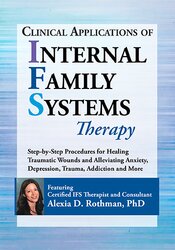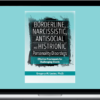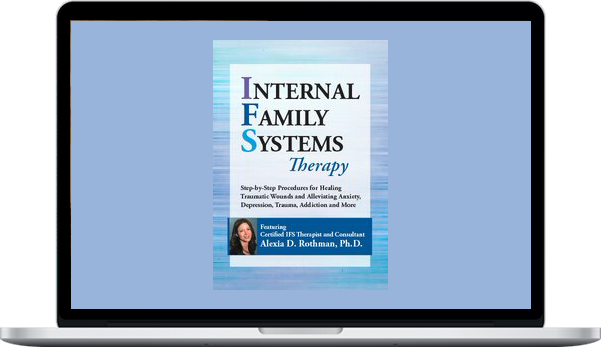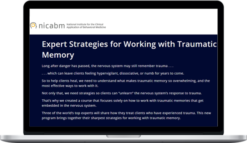Alexia Rothman – Internal Family Systems Therapy
$109.00 $28.80
Total Sold: 4
»Instant Delivery
Description
Alexia Rothman – Internal Family Systems Therapy

After decades of clinical innovation and recent scientific research, the empirically validated Internal Family Systems (IFS) model has been shown to be effective at improving clients’ general functioning and well-being. This effective model provides clinicians with procedures for helping clients with the most challenging mental health profiles to heal the wounded, burdened, and traumatized parts of their systems.
The IFS model provides a compassionate, respectful, non-pathologizing approach to understanding the organization and functioning of the human psyche.
The transformative IFS approach embraces and celebrates the natural multiplicity of the mind. Its assumption that every part of the system has good intention and valuable resources allows clinicians to approach even the most troubling of “symptoms” with compassion and respect. IFS offers therapists a powerful and effective set of tools for empowering clients with a wide range of clinical profiles to heal the wounded and burdened parts of their internal systems, resulting in:
- A way to enter clients’ inner ecology without the overemphasis on containment and stabilization
- Symptom reduction and improved functioning for clients
- Deep self-healing within even the most troubled clients
IFS is a powerful treatment modality. Once you experience it, you will want to incorporate it into your practice.
Through instruction, video demonstration, and experiential exercises, Alexia Rothman, Ph.D., Certified IFS therapist and college of Dr. Richard Schwartz (founder of IFS) will show you step-by-step how to apply the most effective, empirically validated IFS interventions to help your clients connect with and understand their conflicting parts to facilitate deep, lasting healing.
- Present the origins and development of the Internal Family Systems Model, including empirical support for the model and the current status of research using IFS to treat posttraumatic stress disorder.
- Provide an in-depth overview of IFS theory, basic principles, assumptions of the model and its treatment implications.
- Describe the three major components of the psyche as outlined by IFS (parts, burdens, and the Self) including the characteristics of and assumptions regarding each component as they relate to clinical practice.
- Discuss the goals of IFS therapy and case conceptualization through an IFS lens.
- Provide a grounding in IFS procedures and techniques that can be implemented immediately in clinical and personal work, including the steps for facilitating the development of Self-Part relationships.
- Summarize the steps of healing and unburdening wounded parts of the system in session.
Internal Family Systems (IFS)
- Comprehensive, compassionate, non-pathologizing treatment approach
- Paradigm-shifting perspective on “psychopathology”
- Easily integrated into other therapeutic modalities
- Teach clients to access inner wisdom and self-compassion to permanently heal traumatic wounds
Evolution of the Model
- Development of the IFS model by Richard C. Schwartz, Ph.D.
- IFS as an empirically validated treatment: Summary of research support
Composition of the Psyche
- Concept of multiplicity: “We are all multiple personalities.”
- Components of the psyche:
- Wounded, vulnerable, parts
- Protective parts: proactive and reactive
- Burdens: Negative beliefs about oneself
- The Self: compassionate inner leader and internal source of wisdom and healing energy
- Guide clients to access their own inner wisdom and healing potential
- IFS-specific techniques for in-the-moment emotion regulation, helpful even with panic, flashbacks, and dissociation
The IFS Model
- Assumptions of the model
- Goals of IFS therapy
- Flow of the IFS model over the course of treatment
- Flow of an individual IFS session
Case conceptualization in IFS
Diversity and cultural sensitivity
How IFS understands Personality Disorders, Dissociative Identity Disorder, and Addiction
IFS Step-by-Step
Step 1: Using Meditative Processes to Identify and Connect with a Target Part
- Differentiate the person from the symptom
- Access a state of compassion and curiosity essential for healing
- Establish a relationship with the target part
- Learn the history and benevolent intention behind the symptom
Step 2: Working with Protective Parts
- Facilitate internal attachment work
- Learn and address the fears/concerns of protective parts
- Establish a trusting and appreciative relationship with proactive and reactive protectors
- Gain permission to proceed to healing
Step 3: Healing the Traumatic Wound
- Develop a compassionate, connected relationship with the wounded part
- Witness the pain rather than re-experience it: Learn to be “with”, not “in”, to avoid re-traumatization
- Retrieve the wounded part from “trauma time”
- Release/unburden thoughts, feelings, and beliefs
- Integrate change into the system and use maintenance and troubleshooting strategies
Bringing IFS Concepts to Life
- Experiential exercise
- Video demonstration of IFS therapy with a real client
- Step-by-step commentary to solidify understanding of techniques illustrated in the video session
More courses from the same author: Alexia Rothman
Delivery Policy
When will I receive my course?
You will receive a link to download your course immediately or within 1 to 21 days. It depends on the product you buy, so please read the short description of the product carefully before making a purchase.
How is my course delivered?
We share courses through Google Drive, so once your order is complete, you'll receive an invitation to view the course in your email.
To avoid any delay in delivery, please provide a Google mail and enter your email address correctly in the Checkout Page.
In case you submit a wrong email address, please contact us to resend the course to the correct email.
How do I check status of my order?
Please log in to HealingCourse account then go to Order Page. You will find all your orders includes number, date, status and total price.
If the status is Processing: Your course is being uploaded. Please be patient and wait for us to complete your order. If your order has multiple courses and one of them has not been updated with the download link, the status of the order is also Processing.
If the status is Completed: Your course is ready for immediate download. Click "VIEW" to view details and download the course.
Where can I find my course?
Once your order is complete, a link to download the course will automatically be sent to your email.
You can also get the download link by logging into your HealingCourse account then going to Downloads Page.
Related products
Total sold: 2
Total sold: 3










